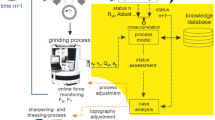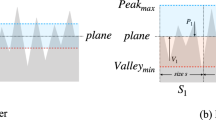Abstract
Mechanical polishing is a finishing process practiced conventionally to enhance quality of surface. Surface finish is improved by mechanical cutting action of abrasive particles on work surface. Polishing is complex in nature and research efforts have been focused on understanding the polishing mechanism. Study of changes in profile is a useful method of understanding behavior of the polishing process. Such a study requires tracing same profile at regular process intervals, which is a tedious job. An innovative relocation technique is followed in the present work to study profile changes during mechanical polishing of austenitic stainless steel specimen. Using special locating fixture, micro-indentation mark and cross-correlation technique, the same profile is traced at certain process intervals. Comparison of different parameters of profiles shows the manner in which metal removal takes place in the polishing process. Mass removal during process estimated by the same relocation technique is checked with that obtained using weight measurement. The proposed approach can be extended to other micro/nano finishing processes and favorable process conditions can be identified.










Similar content being viewed by others
References
E. Rabinowicz, L.A. Dunn, P.G. Russell, A study of abrasive wear under three-body conditions. Wear 4, 345–355 (1961)
R.L. Aghan, L.E. Samuels, Mechanisms of abrasive polishing. Wear 16, 293–301 (1970)
R. Komanduri, D.A. Lucca, Y. Tani, Technological advances in fine abrasive processes. Ann CIRP Manuf Technol 46(2), 545–596 (1997)
T. Kasai, K. Horio, A. Kobayashi, Improvement of conventional polishing conditions for obtaining super smooth surfaces of glass and metal works. Ann CIRP Manuf Technol 39(1), 321–324 (1990)
C.J. Evans, E. Paul, D. Dornfeld, D.A. Lucca, G. Byrne, M. Tricard, F. Klocke, O. Dambon, B.A. Mullany, Material removal mechanisms in lapping and polishing 2003. Ann CIRP Manuf Technol 52(2), 611–633 (2003)
L.E. Samuels, B. Wallace, Effects of type and size of diamond abrasives on material removal rates in metallographic polishing. Metallography 17, 19–41 (1984)
Y. Xie, B. Bhushan, Effects of particle size, polishing pad and contact pressure in free abrasive polishing. Wear 200, 281–295 (1996)
L.S. Deshpande, S. Raman, O. Sunanta, C. Agbaraji, Observations in the flat lapping of stainless steel and bronze. Wear 265, 105–116 (2008)
R.E. Parks, C.J. Evans, Rapid post-polishing of diamond-turned optics. Precis Eng 16, 223–227 (1994)
R. Chauhan, Y. Ahn, S. Chandrasekar, T.N. Farris, Role of indentation fracture in free abrasive machining of ceramics. Wear 162–164, 246–257 (1993)
V.H. Bulsara, Y. Ahn, S. Chandrasekar, T.N. Farris, Mechanics of polishing. J Appl Mech 65, 410–416 (1998)
S.H. Chang, T.N. Farris, S. Chandrasekar, Contact mechanics of superfinishing. J Tribol 122, 388–393 (1999)
X. Zhu, C. Chung, C.S. Korach, I. Kao, Experimental study and modeling of the effect of mixed size abrasive grits on surface topology and removal rate in water lapping. Wear 305, 14–22 (2013)
L. Zhou, S.T. Huang, X.L. Wang, L.F. Xu, High-speed mechanical lapping of CVD diamond films using diamond wheel. Int J Refract Met Hard Mater 35, 185–190 (2012)
T.C. Hung, S.H. Chang, C.C. Lin, Y.T. Su, Effects of abrasive particle size and tool surface irregularities on wear rates of work and tool in polishing processes. Microelectron Eng 889, 2981–2990 (2011)
X.L. Jin, L.C. Zhang, A statistical model for material removal prediction in polishing. Wear 274–275, 203–211 (2012)
C. Fan, J. Zhao, L. Zhang, Y.S. Wong, G.S. Hong, W. Zhou, Modeling and analysis of the material removal profile for free abrasive polishing with sub-aperture pad. J Mater Process Technol 214, 285–294 (2014)
H. Aida, S.W. Kim, K. Ikejiri, T. Doi, T. Yamazaki, K. Seshimo, K. Koyama, H. Takeda, N. Aota, Precise mechanical polishing of brittle materials with free diamond abrasives dispersed in micro–nano-bubble water. Precis Eng 40, 81–86 (2015)
G. Savio, R. Meneghello, G. Concheri, A surface roughness predictive model in deterministic polishing of ground glass moulds. Int. J. Mach. Tools Manuf 49, 1–7 (2009)
S.H. Chang, Basic study of superfinishing of hardened steels. Ph.D. Thesis, Purdue University, USA, 1998
J.B.P. Williamson, R.T. Hunt, Relocation profilometry. J Phys E Sci Instrum 1, 749–752 (1968)
D.J. Whitehouse, The measurement and analysis of surfaces. Tribology 7, 249–259 (1974)
D.J. Whitehouse, Surfaces and Their Measurement (Hermes Penton, London, 2002)
M.S. Shunmugam, D.J. Whitehouse, Surfaces and surface metrology. Int J Precis Technol 3, 317–332 (2013).
A.H. Uppal, S.D. Probert, Deformation of single and multiple asperities on metal surfaces. Wear 20, 381–400 (1972)
V. Radhakrishnan, O.V.K. Chetty, B.T. Achyutha, Application of a relocation technique to the study of surface production in electrochemical machining and electrodischarge machining. Wear 68, 1–6 (1981)
X. Roizard, J. von Stebut, Surface asperity flattening in sheet metal forming—a 3-D relocation stylus profilometric study. Int J Mach Tools Manuf 35(2), 169–175 (1995)
S.C. Kumaran, M.S. Shunmugam, Study of profile changes in magneto-rheological abrasive honing by an ingenious relocation technique, Proceedings of 5th International and 26th All India Manufacturing Technology Design and Research Conference, AIMTDR, Art 874, 1–6, 2014
M.S. Shunmugam, V. Radhakrishnan, Selection and fitting of reference line for surface profiles. Proc IMechE, Lond 190(7/76), 193–201 (1976)
J. Kumar, M.S. Shunmugam, Fitting of a robust reference profile for separation of form and waviness from surface profiles. Trans NAMRI/SME 34, 523–530 (2006)
A. Pogačnik, M. Kalin, How to determine the number of asperity peaks, their radii and their heights for engineering surfaces: a critical appraisal. Wear 300, 143–154 (2013)
Acknowledgements
Authors are thankful to the sponsoring agencies DST (Grant No. SR/S3/MERC-68/2004 dated 08-06-2007) and IIT Madras (Grant No. MEE/03-04/181/IDRP/OVKC dated 01-10-2003) for providing the measurement facilities, at the Manufacturing Engineering Section, necessary to carry out the present investigation.
Author information
Authors and Affiliations
Corresponding author
Rights and permissions
About this article
Cite this article
Kumaran, S.C., Shunmugam, M.S. Study of Profile Changes during Mechanical Polishing using Relocation Profilometry. J. Inst. Eng. India Ser. C 100, 203–212 (2019). https://doi.org/10.1007/s40032-017-0387-5
Received:
Accepted:
Published:
Issue Date:
DOI: https://doi.org/10.1007/s40032-017-0387-5




